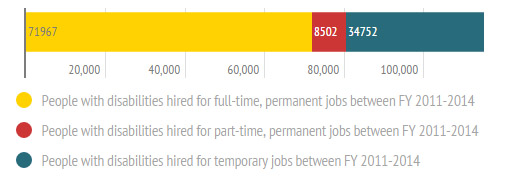Why a record number of people with disabilities work for the government
Government officials are starting to brag that, despite budget cuts and hiring freezes, the Obama administration will have achieved an ambitious hiring goal by the...
Government officials are starting to brag that, despite budget cuts and hiring freezes, the Obama administration will have achieved an ambitious hiring goal by the end of next month: To add 100,000 new employees with disabilities over a five-year period.
President Barack Obama set that target in a 2010 executive order that called on the government to be a model employer of people with disabilities. In it, he noted that agencies had failed to meet a similar goal that President Bill Clinton laid out 10 years earlier. This time would be different, according to the directive. Agencies would have specific targets to meet. Senior-level officials would be on the hook if they failed to deliver.
The most recent figures show the strategy is working. The government added more people with disabilities to its rolls in fiscal 2014 than at any time in the 34 years since it began tracking the data. More than 20,000 people with disabilities started full-time, permanent federal positions last year. Nearly 2,400 other employees began part-time or seasonal jobs last year. They represent about one-fifth of new federal hires, according to data from the Office of Personnel Management.

The Office of Personnel Management will not detail similar statistics for 2015 — the last of the five years in the executive order — for several months. But Michael Murray, OPM’s special adviser on disability programs, said he believes the upward trend will continue.
“We’ll get really close, if not make it,” he said.
In fact, the government already has achieved its goal, if temporary and seasonal workers are included. The executive order did not specify what sort of jobs should count toward the 100,000 figure. Between October 2010 and October 2014, the government hired 71,967 people with disabilities for full-time, permanent positions. Part-timers and seasonal workers boosted that figure to 80,469. If temporary workers are included too, then the government hired 115,221 people with disabilities in those four years.

“No matter how you look at this data, we’re doing amazing stuff,” said Murray.
He said the executive order kick-started the process. But other policies have helped. Agencies can appoint veterans who are at least 30-percent disabled to jobs without going through the normal hiring process. Veterans made up nearly half of the new hires with disabilities in 2014. The process is especially attractive to agencies at a time when a single ad on the government’s hiring portal USAJobs.gov can bring in hundreds or more applications, overwhelming agency human resources departments and hiring managers.
Healthy finances help too. Two years of budget cuts slowed hiring in 2012 and 2013, throwing agencies off track. They picked up the pace in 2014, adding 104,435 full-time permanent jobs. But in order to claim that the government has put persons with disabilities in 100,000 full-time, permanent positions by October, agencies will have to do even better.
“If you bust your butt between now and the end of the year, you can make it happen,” said Murray.
While he said he believes agencies will achieve that goal, he acknowledged that the government is not yet the model employer of people with disabilities that it has striven to be under successive presidents. For one thing, people with more severe disabilities — known as “targeted disabilities” in OPM parlance — represent 1 percent of the entire civilian workforce and a similar fraction of the new hires with disabilities.
For another, people with disabilities are much more likely than other federal workers to quit or be fired because of a performance-related issue.
“It’s a matter of a lot of things: education, having good matches for the jobs from the very beginning, having reasonable accommodations in place,” said Murray.
Before joining OPM, Murray advised companies on employing people with disabilities. He said the government could learn from Wal-Mart, which pre-approves 500 types of accommodations for employees who need them.
“You ask for it, you get it,” he said. “In a lot of ways, that makes sense from a business perspective because there’s less process, less paperwork and it costs less. We’re ensuring that folks who need things to get their work done are given it in a quick and efficient manner.”
In contrast, federal employees who participated in a discussion about disability hiring at an EEOC-sponsored conference in Washington this week complained about the time it can take to get special technology or other assistance to do their jobs. One woman tugged on her ears to point out her cochlear implants. She said she could not understand why her agency required her to fill out so much paperwork when it was obvious that she was deaf.
Employees have a role to play too, said Murray.
“Part of it also comes back to those of us with disabilities and making sure we’re educated and ready to enter the workforce and continue with what we’re doing,” he said. He is encouraged by the fact that each year, more federal employees are coming forward to say that they have disabilities.
The end of next month represents the deadline set out in the President’s executive order. But Murray said he hoped the government would set new goals rather than rest on its laurels.
“Our goal was to have the federal government reflect the society that we serve and, as people with disabilities are the nation’s largest minority population, we’re still not there even though we’ve done incredible work and moved in the right direction,” he said.
Copyright © 2025 Federal News Network. All rights reserved. This website is not intended for users located within the European Economic Area.


